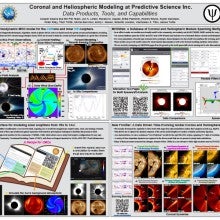Coronal and Heliospheric Modeling Tools, Data Products, and Capabilities at Predictive Science Inc.
Cooper
Downs
Predictive Science Inc.
Jon A. Linker (PSI),
Ronald M. Caplan (PSI),
Andres Reyes (PSI),
Ryder Davidson (PSI),
Peter Riley (PSI),
Tibor Török (PSI),
Michal Ben-Nun (PSI),
Erika Palmerio (PSI),
Emily I. Mason (PSI),
Roberto Lionello (PSI),
Viacheslav S. Titov (PSI),
James Turtle (PSI)
Ronald M. Caplan (PSI),
Andres Reyes (PSI),
Ryder Davidson (PSI),
Peter Riley (PSI),
Tibor Török (PSI),
Michal Ben-Nun (PSI),
Erika Palmerio (PSI),
Emily I. Mason (PSI),
Roberto Lionello (PSI),
Viacheslav S. Titov (PSI),
James Turtle (PSI)
Oral and Poster
In this presentation we briefly summarize the suite of coronal and heliospheric models and tools developed at Predictive Science Inc. (PSI). Powered by the global coronal thermodynamic MHD code, MAS, and its associated coronal and heliospheric modeling suite, CORHEL, we provide an overview of several items that may be of interest to or useful for scientists working with PUNCH observations. This includes:
(1) MHDWeb: A large database of MHD simulations routinely updated at least once per Carrington rotation by PSI for the community. The associated web interface (www.predsci.com/mhdweb) includes interactive visualizations, spacecraft mappings, and raw model data that can be accessed online or through the SSW FORWARD package for case-study context and analysis;
(2) CORHEL-CME: A rich web interface hosted at the Community Coordinated Modeling Center (CCMC) that allows users to study eruptive configurations for any time of interest and launch Sun-to-Earth CME simulations through the CCMC Runs on Request system (ccmc.gsfc.nasa.gov/models/CORHEL-CME~1);
(3) New modeling capabilities that leverage surface flux-transport models to incorporate data assimilation and data-driven approaches directly into the thermodynamic MHD calculation (e.g. www.predsci.com/eclipse2024). This allows one to capture a time-evolving, dynamically driven corona and heliosphere from 1 Rs to 1 AU in the simulation, which has important implications for understanding the dynamics and underlying connectivity of white-light structures observed in the PUNCH fields of view.
(1) MHDWeb: A large database of MHD simulations routinely updated at least once per Carrington rotation by PSI for the community. The associated web interface (www.predsci.com/mhdweb) includes interactive visualizations, spacecraft mappings, and raw model data that can be accessed online or through the SSW FORWARD package for case-study context and analysis;
(2) CORHEL-CME: A rich web interface hosted at the Community Coordinated Modeling Center (CCMC) that allows users to study eruptive configurations for any time of interest and launch Sun-to-Earth CME simulations through the CCMC Runs on Request system (ccmc.gsfc.nasa.gov/models/CORHEL-CME~1);
(3) New modeling capabilities that leverage surface flux-transport models to incorporate data assimilation and data-driven approaches directly into the thermodynamic MHD calculation (e.g. www.predsci.com/eclipse2024). This allows one to capture a time-evolving, dynamically driven corona and heliosphere from 1 Rs to 1 AU in the simulation, which has important implications for understanding the dynamics and underlying connectivity of white-light structures observed in the PUNCH fields of view.

Poster PDF
Presentation file
YouTube link
Meeting homepage